
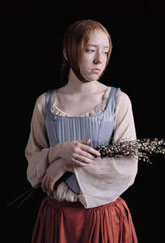
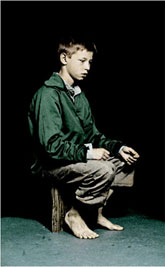
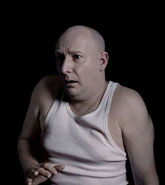
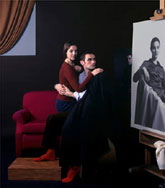


Foundation
3,14 and Mark Thompson presents Paul Hodgson at the M.K.Ciurlionis State Museum
of Art, Kaunas, Lithuania
A NEW PHOTOGRAPHIC SPIN ON OLD MASTERS INTRIGUES
Writes Joanna Pitman for The Times, London
"In 1568 Georgio Vasari declared in his influential book, Vite, that art had "reached the height of what a true imitator of nature is capable of achieving" thanks to the efforts of Raphael, Michelangelo and Leonardo da Vinci.
Almost 500 years on, Paul Hodgson, a 30-year-old photographer, is making photographic work that parallels those historic efforts. It involves a kind of mannered reproduction of early portrait paintings. Hodgson restages scenes in the language of contemporary studio photography, nodding to the classical masters of old, but lacing their work with contemporary social and political signals.
Using actors carefully dressed, positioned and immaculately lit, he ensures that all the central components of the original paintings are there - the subtleties of pose, the details of props and their symbolism of money, power or fashion. But rather than recreating them fully, Hodgsom marginally alters them, humbling their finery or jarring the composition with details that are out of harmony, adding anachronisms which allow the image to be more easily interpreted on a personal and contemporary level.
His young female figure in New Land makes reference to Leonardo's Girl with an Emine. Her pose recalls that of the painting but in her arms she cradles a spray of white flowers instead of the white animal. She gazes into the far distance with guarded curiosity, a symbol of innocence eager to discover the truths of the future. But perhaps her apparent innocence is misleading. Perhaps like Cecilia Gallarani, the model for Leonardo's painting who was the mistress of Ludovico Sforza, ruler of Milan, she too hides the secret of impending motherhood.
Company, a huge 9ft long image, deals with aspects of masculinity and dominance, underscored with a powerful sense of threath. Nine thickset men in military or police uniforms stand before what appears to be a freshly dug mass grave. In its carefully judged genuflection to the work of Goya, Hodgson plunges us into the memory of early 20th-century genocide and then pitches us forward to more recent atrocities, forcing us to consider the grim repetitions of history.
Many other photographers have taken pastiche as a strategy in recent times, but often they are seduced by the plush theatricality of the studio and end up with hollow artifice. Hodgson's work is much darker, more threathening, shattering illusions and stamping on complacency."
Hodgson appars courtesy of Houldswoth Gallery, Cork Street, London.
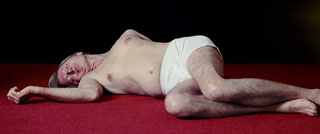
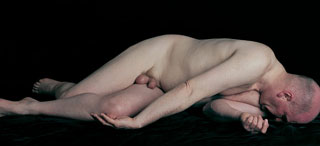




A NEW PHOTOGRAPHIC SPIN ON OLD MASTERS INTRIGUES
Writes Joanna Pitman for The Times, London
"In 1568 Georgio Vasari declared in his influential book, Vite, that art had "reached the height of what a true imitator of nature is capable of achieving" thanks to the efforts of Raphael, Michelangelo and Leonardo da Vinci.
Almost 500 years on, Paul Hodgson, a 30-year-old photographer, is making photographic work that parallels those historic efforts. It involves a kind of mannered reproduction of early portrait paintings. Hodgson restages scenes in the language of contemporary studio photography, nodding to the classical masters of old, but lacing their work with contemporary social and political signals.
Using actors carefully dressed, positioned and immaculately lit, he ensures that all the central components of the original paintings are there - the subtleties of pose, the details of props and their symbolism of money, power or fashion. But rather than recreating them fully, Hodgsom marginally alters them, humbling their finery or jarring the composition with details that are out of harmony, adding anachronisms which allow the image to be more easily interpreted on a personal and contemporary level.
His young female figure in New Land makes reference to Leonardo's Girl with an Emine. Her pose recalls that of the painting but in her arms she cradles a spray of white flowers instead of the white animal. She gazes into the far distance with guarded curiosity, a symbol of innocence eager to discover the truths of the future. But perhaps her apparent innocence is misleading. Perhaps like Cecilia Gallarani, the model for Leonardo's painting who was the mistress of Ludovico Sforza, ruler of Milan, she too hides the secret of impending motherhood.
Company, a huge 9ft long image, deals with aspects of masculinity and dominance, underscored with a powerful sense of threath. Nine thickset men in military or police uniforms stand before what appears to be a freshly dug mass grave. In its carefully judged genuflection to the work of Goya, Hodgson plunges us into the memory of early 20th-century genocide and then pitches us forward to more recent atrocities, forcing us to consider the grim repetitions of history.
Many other photographers have taken pastiche as a strategy in recent times, but often they are seduced by the plush theatricality of the studio and end up with hollow artifice. Hodgson's work is much darker, more threathening, shattering illusions and stamping on complacency."
Hodgson appars courtesy of Houldswoth Gallery, Cork Street, London.












